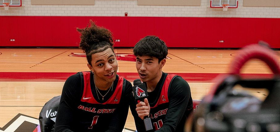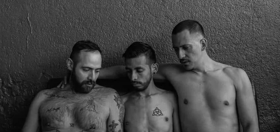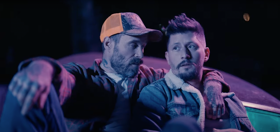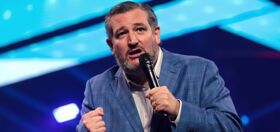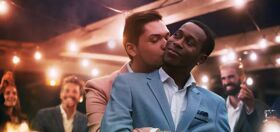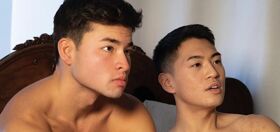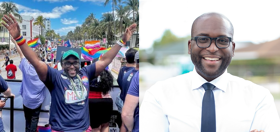
After the censorious Hays Code ended in 1968, Hollywood was suddenly able to make explicitly queer stories. In the 70s, 80s, and 90s, LGBTQ stories and themes began to pop up on screen, but it took time for the movies to start telling stories that were more than just tragic, lazy cautionary tales about gay life and chosen family.
“You can’t plead tolerance for gays by saying that they’re just like everyone else,” The Celluloid Closet author Vito Russo once said. “Tolerance is something we should extend to people who are not like everyone else.”
Today, pop entertainment has moved past telling stories about perfect, tragic LGBTQ people. Fortunately, the movies have also figured out that joy, too, and given us some titles that allow us to celebrate our found flock, with our collected clan. Still, we couldn’t do it without a few important films paving the way and showing the world that queer folks have a beautiful way of creating community all our own.
In honor of that history, and of Queer History Month, we hereby highlight these ten titles that still make us smile, especially when viewed as a family affair.
How about we take this to the next level?
Our newsletter is like a refreshing cocktail (or mocktail) of LGBTQ+ entertainment and pop culture, served up with a side of eye-candy.
Now, pass the popcorn.
The Broken Hearts Club
One of the first-ever movies to celebrate the chosen queer family still holds up as a celebration of love and friendship. Writer/director Greg Berlanti’s tender story of a group of queer people living in Los Angeles who join a gay softball team whilst trying to navigate the ins and outs of dating broke new ground in its depictions of day-to-day life for a group of gay friends–none of whom were cold-blooded villains, victims or dying of AIDS. Rather, the characters help each other out of the closet, survive the misadventures of dating, and find their place in a community that is larger than any one person, kind of like a family. It also would help usher in the careers of Zach Braff, Justin Theroux, Timothy Olyphant, and Billy Porter.
Rocky Horror Picture Show
Oh, but it was great when it all began. This high-camp musical is about a straight and straight-laced couple exploring sexual and gender freedom with a group of aliens flopped on initial release. It did, of course, find new life at midnight showings and helped usher in the era of “Midnight Movies” as a safe space for LGBTQ people. At midnight screenings, the actual eccentrics the film portrayed would pour into the cinema to sing along and holler back at the screen. To this day, it remains a right of passage for so many teenagers–queer and straight alike–who don their fishnet stockings and gather. Together they could watch a chosen family (albeit a dysfunctional one) come together and find a real-life chosen family too. In addition to showing the world what an insane, perverse chosen family might look like, Rocky Horror has created its own chosen family via the film’s devoted fan base. Larry Viezel, the current president of the film’s official fan club: “I know of a lot of people whose lives were saved by this movie, especially for those in the LGBT community, it’s a place where they could be themselves and find people who were their family.”
The Muppet Movie
Ok, no character in The Muppet Movie is explicitly LGBTQ. For that matter, we don’t think Muppet master Jim Henson intended it as a queer metaphor. That said, few movies celebrate finding a chosen family with so much joy, let alone films aimed at kids. For Kermit, Miss Piggy, Gonzo, and the rest chasing stardom mean finding a whole bunch of friends who believe in the same dream, and who will stand up for one another, even in the face of failure or worse. As a technical achievement, The Muppet Movie featured state-of-the-art puppeteering effects, which allowed the Muppet cast members to interact with humans in real-life environments, ride bicycles, drive cars and perform full-bodied tap dances. It also became one of the first movies to feature inter-species romance. For the Muppets, love was love, and a thing to be celebrated no matter the makeup of the couple. That made the film way ahead of its time, and one of the earliest to demonstrate that love makes a family, even one made up of frogs, pigs, chickens, bears, and more.
Pink Flamingoes
Not every family has the same standards of beauty, and John Waters’ seminal film Pink Flamingoes relishes a cast of characters that revel in filth rather than glamour. For these weirdos (and we use the term generously), coming together means finding a family of like-minded misfits to prove they are the trashiest people alive. And hey, if a doggie doo-eating drag queen and an egg-obsessed infant-woman can find love and family, that gives hope to the rest of us. Pink Flamingoes put John Waters on the map as a filmmaker, even as he went about destroying everything that “tasteful” straight people assumed the movies were about–and set off an avalanche of imitators. Much like The Rocky Horror Picture Show, it would also usher in the era of Midnight Movies where queer audiences could gather to revel together. It was a triumph for independent cinema, a triumph for Waters, and most importantly, it introduced legendary drag queen Divine to the world outside of Baltimore. You’re welcome.
The Perks of Being a Wallflower
Few movies understand the trials and travails of high school as well as The Perks of Being a Wallflower. Told from the point of view of Charlie (Logan Lehrman), a depressed teen recovering from a suicide attempt, the story follows a group of school outcasts. That includes Patrick (Ezra Miller), a flamboyantly gay teen who becomes a surrogate older brother to Charlie, and Sam (Emma Watson), a plucky older girl for whom Charlie falls head over heels. Together, the three realize that no matter what misfortunes have befallen them in the past, or what dangers lurk in the future, their love for one another will guide them through, and into the infinite. As one of the first popular YA novels to feature a self-assumed gay kid who actually loves himself and his sexuality, this film broke ground by casting queer actor Ezra Miller as Patrick, a gay kid who celebrates himself and serves as a mentor to Charlie rather than falling into the tired “tragic queer best friend” trope. Miller’s sympathetic portrayal of Patrick didn’t just make audiences fall in love with him years before Love, Simon, and Love, Victor arrived on the scene. But the character didn’t just mean a lot to contemporary teens: “The people who have had the most emotional responses,” Miller told Collider in 2013, “are people who were at that age, at that time [when the film takes place], in the early ‘90s.” Patrick didn’t just set a high standard for modern queer teen films and shows–he helped rewrite the painful, erased history of ’90s teens who didn’t see themselves in any entertainment growing up.
The Birdcage
Nobody thought that a remake of a gay French farce was about to be the hit of 1996, but The Birdcage, directed by Mike Nichols and adapted by Elaine May, was precisely that. More importantly, it was one of the first mainstream movies that centered the gay characters as the ones to root for. It was the straight people who were the villains. When gay couple Armand (Robin Williams) and Albert (Nathan Lane) have to prepare for an impromptu visit from Armand’s son Kevin’s soon-to-be conservative inlaws, they go to work at once de-gaying the house, which is a struggle, because it’s only slightly less campy than the drag club Armand owns. The film’s queer characters band together to make sure the “deception” works, including their live-in “houseman” Agador Spartacus (Hank Azaria). In the end, the effect is of a merging of chosen family and biological family to create one, glorious mix. Also, Gene Hackman in a cotton-candy wig.
Boys on the Side
What’s better than a road trip movie? A lesbian road trip movie starring Whoopi Goldberg, obvi. Goldberg plays Jane, a down-and-out New York musician who just broke up with her girlfriend and is ready to start over again in Los Angeles. After answering an ad in the paper, she meets Mary-Louise Parker’s Robin, an uptight realtor living with HIV. On their cross-country trip, the two save Jane’s friend Holly (Drew Barrymore) from her abusive boyfriend and form their own chosen family after realizing that Holly is pregnant. And although Robin doesn’t confess her love for Jane until the very end, it’s clear that these three have created an enduring bond. Sadly, it’s short-lived: Complications due to HIV end Robin’s life, leaving Jane to hit the road solo once more. Although by 1995 the AIDS crisis was already raging, there were still so many misconceptions about PLWH floating around that movies like Boys on the Side, Love, Valour, Compassion, and Jeffrey were able to play a huge role in by putting a face to the epidemic. In the public mind, AIDS/HIV might have been a “gay disease,” but breakthrough films like this one showed that anyone, anywhere could be vulnerable to it. Even a buttoned-up, ostensibly straight woman like Robin.
Punks
When the Babyface-produced Punks came out in 2000, it laid the framework for what would become auteur Patrik-Ian Polk’s seminal series Noah’s Arc. Punks concerns a group of four gay, Black men–Marcus, Dante, Hill, and Darby–trying to break into the L.A. scene at the turn of the 21st century. Punks, as writer Kai Wright describes it, was like “Sex and the City for Black gay men.” There was the “sassy queen, the muscle boy, the butch guy,” and of course the obligatory b plot about being attracted to your straight roommate. Though Punks is considered a hugely influential film and Polk’s career–including production and writing credits on the Gabrielle Union vehicle Being Mary Jane and the queer favorite P-Valley-–Punks remains impossible to view due to the unlicensed use of Sister Sledge songs. But can that take away its place in the pantheon? Not a chance. This indie film took the “ragtag chosen family” sitcom format of Friends and Girlfriends and made it explicitly gay.
Paris is Burning
It was the documentary that changed everything. In 1990, filmmaker Jennie Livingston set out to document the vibrant lives of the queens of New York City’s underground ball scene. From mopping to voguing, Livingston’s film lets viewers in on the glamorous elements of ball culture, in sharp contrast to the difficult, dangerous lives the queens themselves had to live. They can only get through it by banding together, creating competitive houses that also serve as a way to keep vulnerable young trans women off the street. One of the most tragic aspects of Paris is Burning is the death of Venus Xtravaganza, who was murdered by a John before the film ended shooting. In Venus’s struggle, audiences could see the pain, beauty, and desperation of drag queens and trans women trying desperately to survive in a “rich, white world.” And perhaps most importantly: it’s the film that set the stage of Pose.
Jeffrey
Before Paul Rudnick was a household name, he wrote a hilariously goofy comedy called “Jeffrey” in 1996. The film concerns Jeffrey (Steven Weber) as he struggles with finding love at the height of the AIDS crisis. When Jeffrey finally meets the guy who might be the one, he backs away after learning of his love interest’s HIV-positive status. It takes a rag-tag group of queer friends–including Patrick Stewart and a pre-Mad Men Bryan Batt–to get Jeffrey to see the light. Equal parts hilarious and deeply moving, this slightly-dated classic is a true ensemble effort and a nod to the power of queer friendship. Instead of leaning into the tragedy, Jeffrey is notable for its goofy, enlightened take on the fears and phobias surrounding a community ravaged by the HIV crisis. It showed that sure, we could all die any day. But does that mean we should stop enjoying life and seeking out love and sex from sultry strangers at the gym? Absolutely not.


